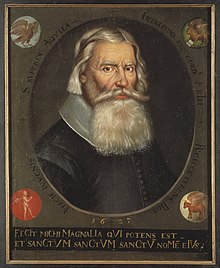Johannes Bureus

Johannes Thomae Bureus Agrivillensis (born Johan Bure; 1568–1652) was a Swedish polymath, antiquarian, mystic, royal librarian, poet, and tutor and adviser of King Gustavus Adolphus of Sweden. He is a well-known exponent of Gothicism.
Life and career
[edit]Bureus was born in 1568 in Åkerby near Uppsala – where the largest and last of the pagan temples once was – in Sweden, as a son of a Lutheran parish priest. He was Sweden's first national antiquarian (riksantikvarie) and first head of Sweden's national library (riksbibliotekarie). He was also the first to document runes.[1] He has been called the father of the Swedish grammar. In 1599, he designed the coats of arms of Helsinki and Uusimaa.[2]
Bureus combined his runic and esoteric interests in his own runic system, which he called the "Adalruna". He was interested in the Rosicrucian manifestos. Contemporary mystics such as Jakob Böhme have studied his works.[3] In 1611, Bureus published the first ever ABC book written in – and about – the Swedish language, Svenska ABC boken medh runor, using the runic alphabet and Latin script. He also wrote a genealogy of the Bure family, partly using runestones as sources.
References
[edit]- ^ Thunberg, Carl L., Ingvarståget och dess monument (”The Ingvar Expedition and its Monuments”), University of Gothenburg, 2010, pp. 12-13.
- ^ Kari Tarkiainen: Ruotsin itämaa ("The Eastern Land of Sweden"), pages 47–49. Publisher: Svenska litteratursällskapet i Finland. Helsinki, 2010.
- ^ Lewis, Bailey Margaret, Milton and Jakob Boehme; A Study of German Mysticism in Seventeenth-Century England (1914).
Further reading
[edit]- Thomas Karlsson: Götisk kabbala och runisk alkemi: Johannes Bureus och den götiska esoterismen. (Dissertation, Stockholm 2010.)
- Håkan Håkansson: Alchemy of the Ancient Goths: Johannes Bureus’ Search for the Lost Wisdom of Scandinavia. Early Science and Medicine 17 (2012), pp. 500–522. View article
External links
[edit]- Article in English Gangleri's article with bibliographical references and more links.
- Short article about the Rune Cross.
- Swedish academic biography stubs
- 1568 births
- 1652 deaths
- 16th-century Christian mystics
- 17th-century antiquarians
- 17th-century Christian mystics
- 17th-century linguists
- Grammarians from Sweden
- Linguists from Sweden
- People from Uppsala Municipality
- Rosicrucians
- Runologists
- Swedish antiquarians
- Swedish Christian mystics
- Swedish genealogists
- Swedish librarians
